Creating an AWS Hosted VIF for an MVE with VMware SD-WAN
Hosted VIFs can connect to public or private AWS cloud services: a Hosted VIF cannot connect to a transit virtual interface. These connections share bandwidth.
To create a Hosted VIF from an MVE to AWS
-
In the Megaport Portal, go to the Services page and select the MVE for the connection.
-
Click +Connection and click Cloud.
-
Select AWS as the service provider, select Hosted VIF as the AWS Connection Type, select the destination port, and click Next.
You can use the Country filter to narrow the destination selection.
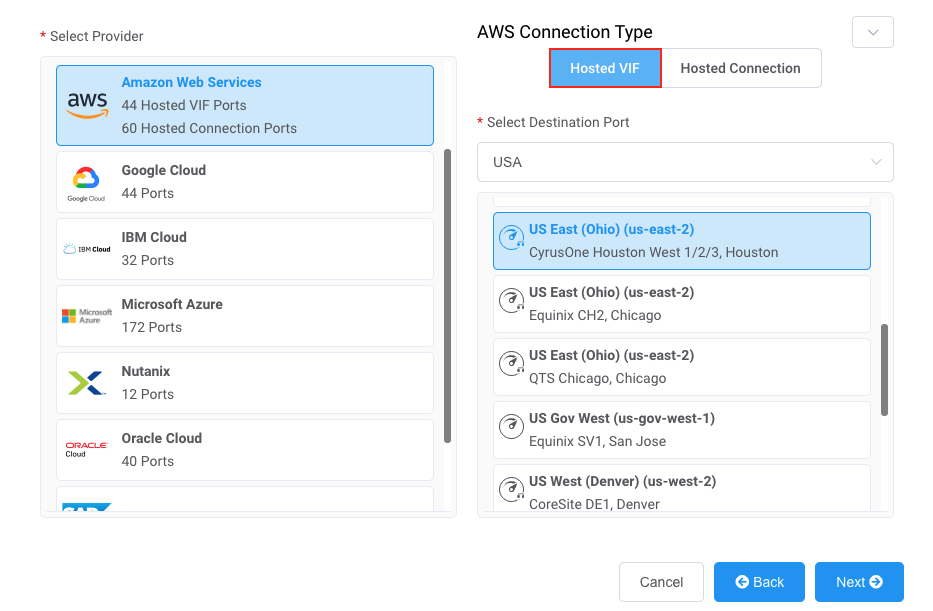
-
Specify the connection details:
-
Connection Name – The name of your VXC to be shown in the Megaport Portal.
Tip
Match this to the AWS Connection Name on the next screen for easy mapping.
-
Service Level Reference (optional) – Specify a unique identifying number for your Megaport service to be used for billing purposes, such as a cost center number, unique customer ID, or purchase order number. The service level reference number appears for each service under the Product section of the invoice. You can also edit this field for an existing service.
-
Rate Limit – The speed of your connection in Mbps. Accepted values start at 1 Mbps and scale in 1 Mbps increments. Maximum available speed depends on location and service availability. Note the sum of all hosted virtual VXCs to a service can exceed the MVE capacity, but the total aggregate will never burst beyond the MVE capacity.
-
VXC State – Select Enabled or Shut Down to define the initial state of the connection. For more information, see Shutting Down a VXC for Failover Testing.
Note
If you select Shut Down, traffic will not flow through this service and it will behave as if it was down on the Megaport network. Billing for this service will remain active and you will still be charged for this connection.
-
A-End vNIC – Select an A-End vNIC from the drop-down list. For more information about vNICs, see Creating an MVE in the Megaport Portal.
-
Preferred A-End VLAN (optional) – Specify an unused VLAN ID for this connection.
This must be a unique VLAN ID on this MVE and can range from 2 to 4093. If you specify a VLAN ID that is already in use, the system displays the next available VLAN number. The VLAN ID must be unique to proceed with the order. If you don’t specify a value, Megaport will assign one. -
Minimum Term – Select No Minimum Term, 12 Months, 24 Months, or 36 Months. Longer terms result in a lower monthly rate. 12 Months is selected by default. Take note of the information on the screen to avoid early termination fees (ETF).
Enable the Minimum Term Renewal option for services with a 12, 24, or 36-month term to automatically renew the contract at the same discounted price and term length at the end of the contract. If you don’t renew the contract, at the end of the term, the contract will automatically roll over to month-to-month contract for the following billing period, at the same price, without term discounts.
For more information, see VXC Pricing and Contract Terms and VXC, Megaport Internet, and IX Billing.
-
Resource Tags – You can use resource tags to add your own reference metadata to a Megaport service.
To add a tag:- Click Add Tags.
- Click Add New Tag.
- Enter details into the fields:
- Key – string maximum length 128. Valid values are a-z 0-9 _ : . / \ -
- Value – string maximum length 256. Valid values are a-z A-Z 0-9 _ : . @ / + \ - (space)
- Click Save.
If you already have resource tags for that service, you can manage them by clicking Manage Tags.
Warning
Never include sensitive information in a resource tag. Sensitive information includes commands that return existing tag definitions and information that will identify a person or company.
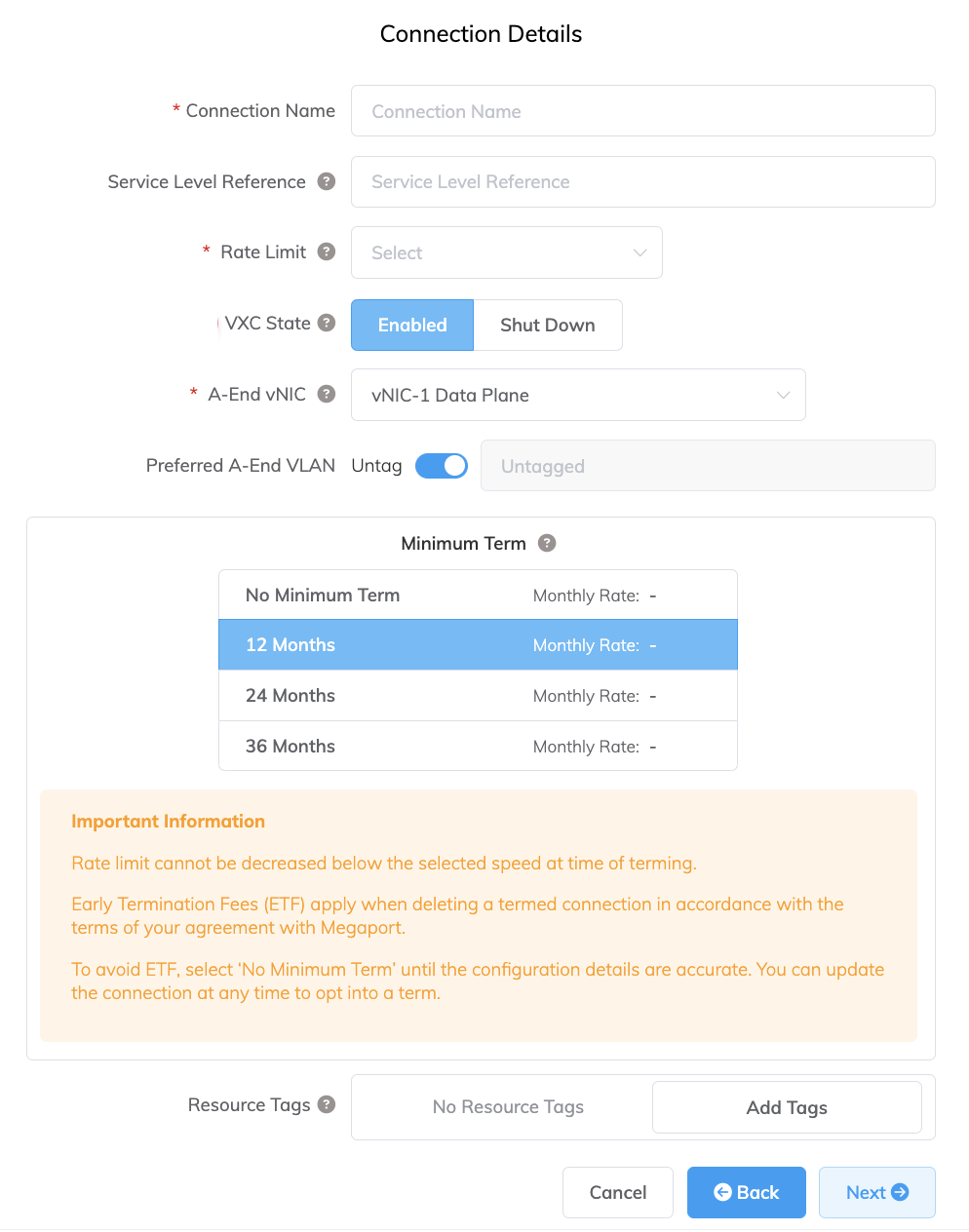
-
-
Click Next.
-
Specify the details for the AWS service.
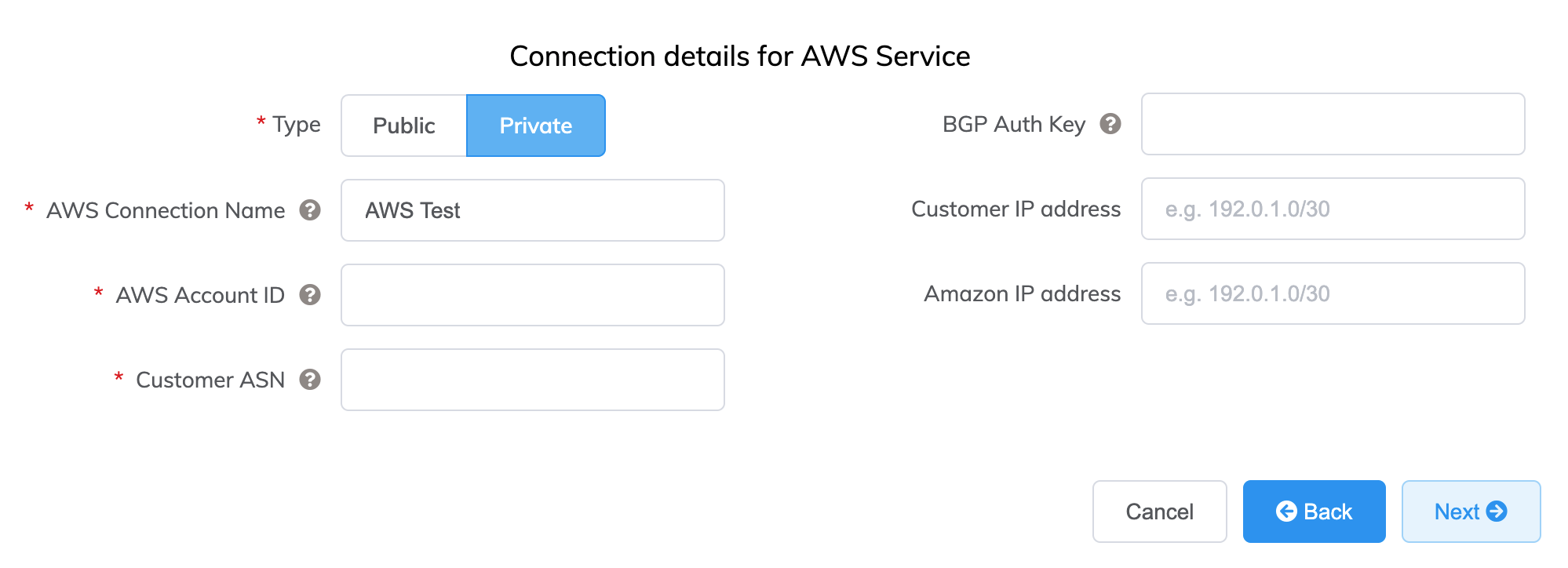
Here are details for each field:
-
Select Public or Private.
- Private – Access private AWS services such as a VPC, EC2 instances, load balancers, RDS DB instances, on private IP address space.
-
Public – Access public AWS services such as Amazon Simple Storage Service (S3), DynamoDB, CloudFront, and Glacier. You’ll also receive Amazon’s global IP prefixes (approximately 2,000 prefixes).
Note
Public VIFs require manual intervention from Amazon and could take up to 72 hours. For more information, see Configuring Public AWS Connections with IP Addresses Provided by AWS.
-
AWS Connection Name – This is a text field and will be the name of your virtual interface that appears in the AWS console. The AWS Connection Name is automatically populated with the name specified in a previous step.
-
AWS Account ID – This is the ID of the account you want to connect. You can find this value in the management section of your AWS console.
-
Customer ASN (optional) – Specify the ASN used for BGP peering sessions on any VXCs connected to the MVE. This value is defined when you configure the MVE and, once defined, it cannot be changed.
-
BGP Auth Key (optional) – Specify the BGP MD5Sometimes known as an MD5 hash or BGP key. The message-digest (MD5) algorithm is a widely used cryptographic function producing a string of 32 hexadecimal digits. This is used as a password or key between routers exchanging BGP information.
key. If you leave this blank, Megaport negotiates a key automatically for you with AWS which will be displayed in the Megaport Portal. The key is not displayed in the AWS console.Note
The BGP Auth Key is generated during the ordering process when this field is left blank. It will not be displayed on the Summary page when ordering. To see the key, view the Connection Settings after the service has been deployed and is live.
-
Customer IP Address – The IP address space (in CIDR format) used on your network for peering. This field is optional for private connections and if left blank, Megaport assigns an address.
-
Amazon IP Address – The IP address space in CIDR format assigned in the AWS VPC network for peering. This field is optional for private connections and if left blank, Megaport automatically assigns an address.
-
Prefixes (optional) – (visible for Public connections only) Specify IP Prefixes to announce to AWS. Specify the prefixes you will advertise when deploying a Public Direct Connect (RIR-assigned IPv4 addresses only).
Once you configure Prefixes for a Public connection, you cannot change them and the field is grayed out. To change this value, create a support ticket with AWS so they can make this change in a non-impacting way. Or, you can cancel the Hosted VIF and reorder. In both cases, you need to wait for AWS to manually approve the request.
-
-
Click Next to proceed to the connection detail summary, add the VXC to the cart, and order the connection.
The AWS VXC appears as a connection for the MVE in the Megaport Portal.
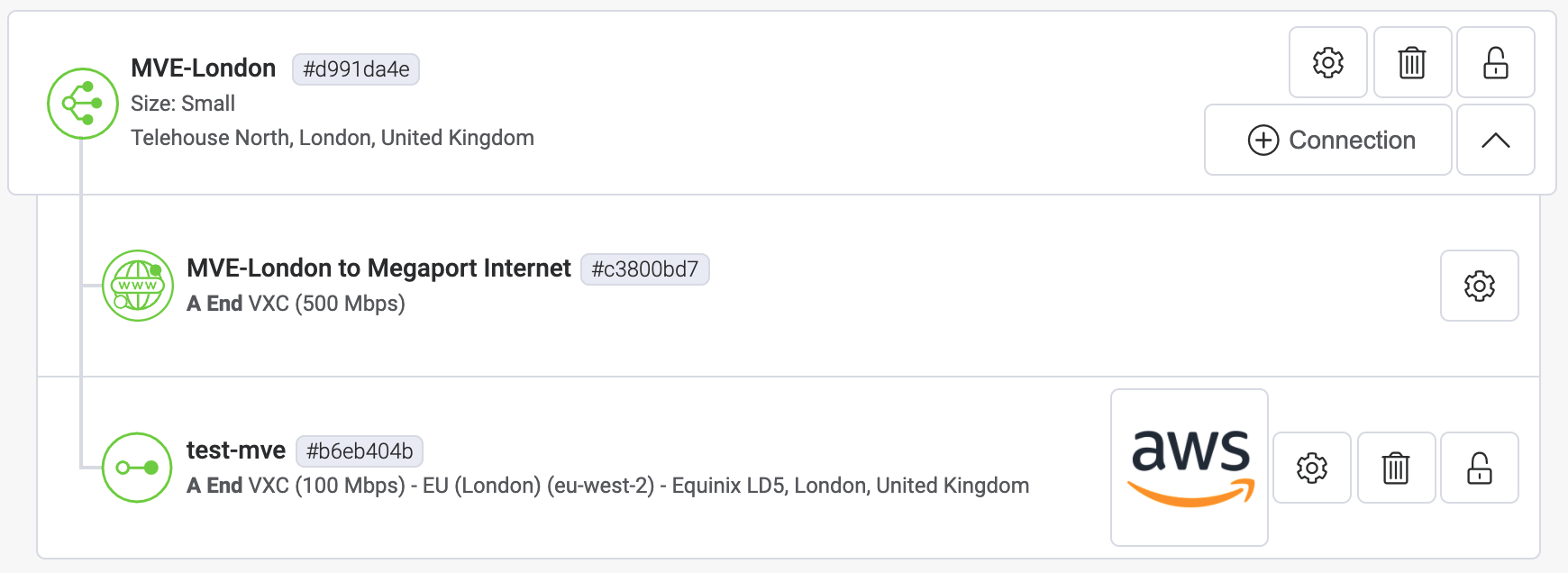
Next, accept the connection in AWS.
Accepting the Virtual Interface for Private Connections
A few minutes after ordering a private Hosted VIF VXC, the corresponding inbound VIF request is visible on the AWS Direct Connect > Virtual Interfaces page in the AWS console. (This is specific to the region associated with the target AWS port.) If your VIF doesn’t appear after a few minutes, confirm that you are viewing the correct region.
To review and accept the private virtual interface
-
From the AWS Direct Connect > Virtual Interface page, click the ID of the interface to display the configuration and peering details.
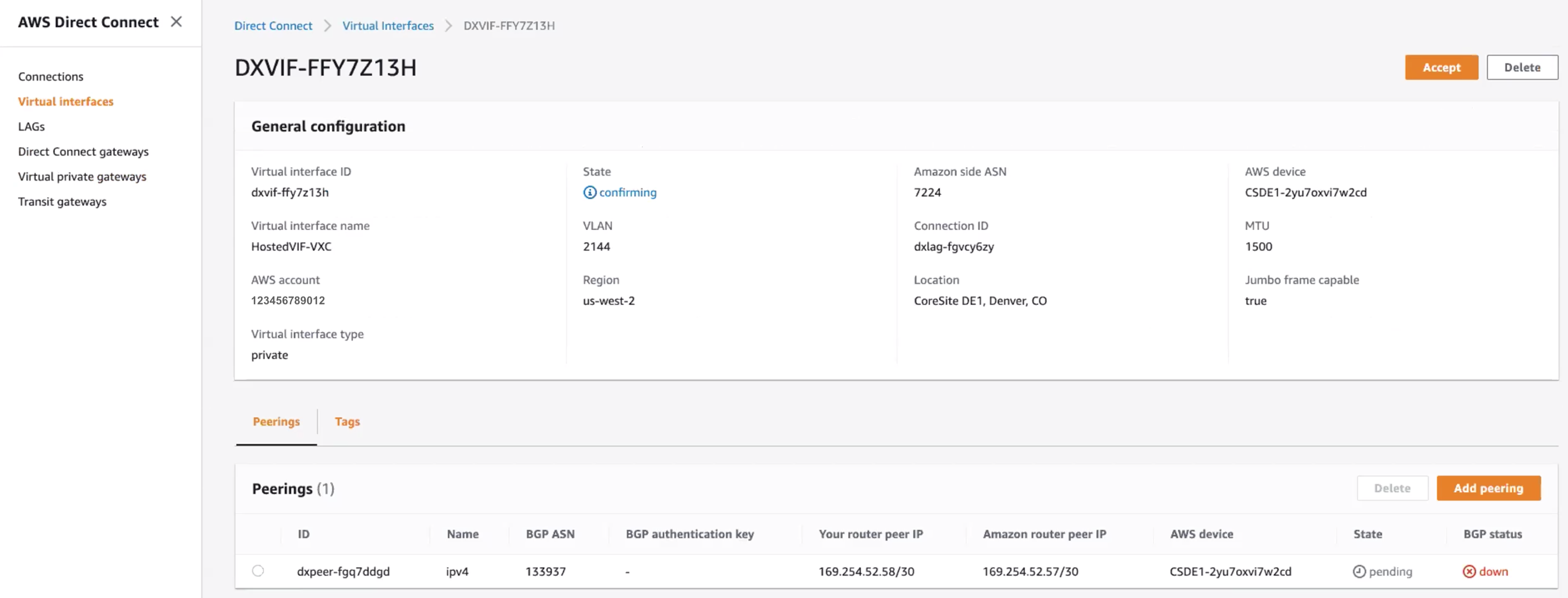
The name and account ID of the VIF should match the values supplied in the Portal and the BGP ASN should match the Customer ASN configured with the VXC. The Amazon ASN is the default region’s AWS ASN and not the value specified during the configuration - this is updated when the virtual interface is accepted and assigned.
-
Click Accept.
-
Select the gateway type and then the specific gateway for this new virtual interface.
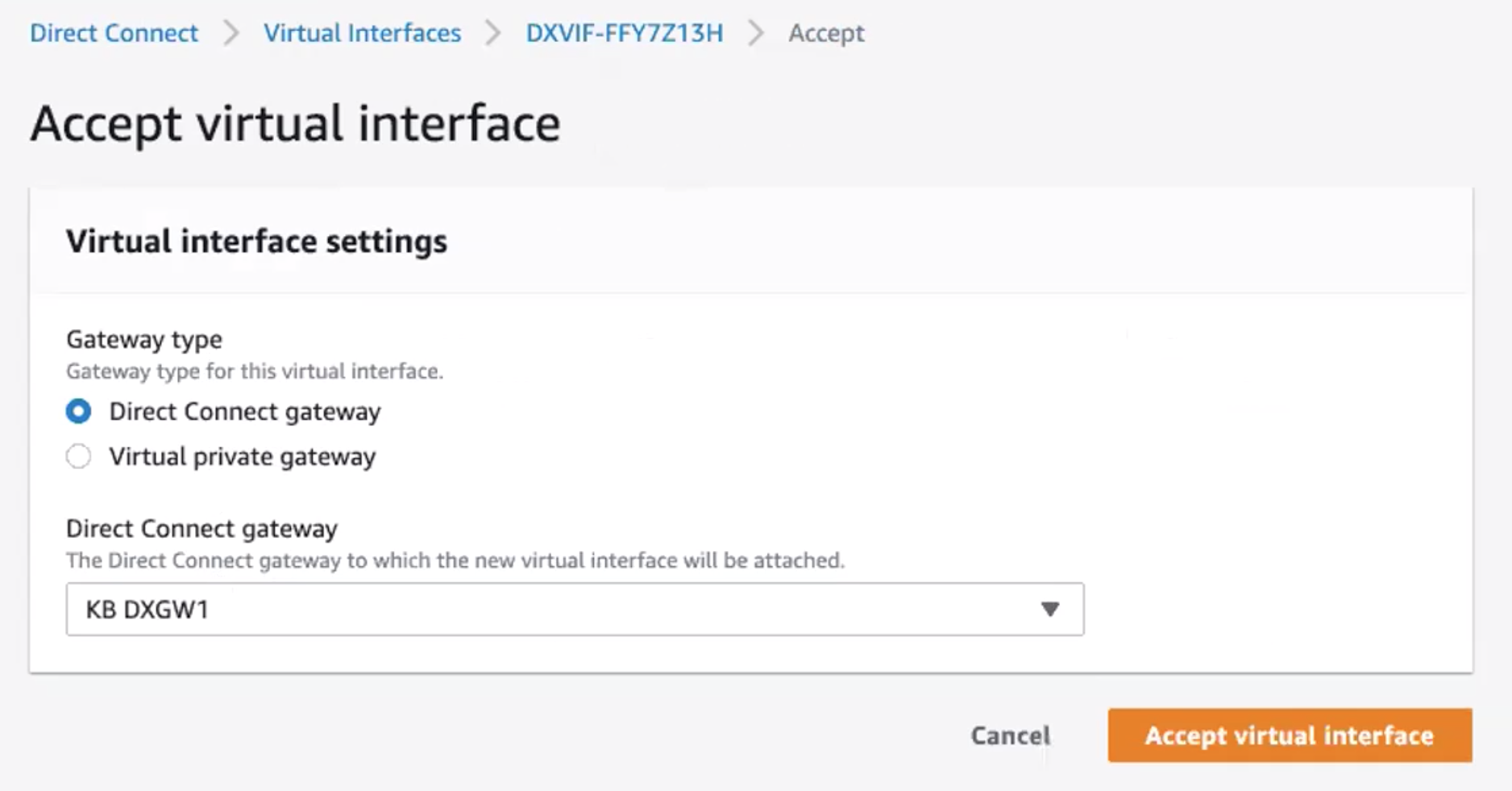
-
Click Accept virtual interface.
The state of the connection changes from confirming to pending, and then changes to available once BGP has established. Note that sometimes there is a delay in the available BGP status appearing on the AWS end, though you can confirm the current state of the Layer 3 link through the Portal view.
Accepting the Virtual Interface for Public Connections
Several minutes after ordering a public Hosted VIF VXC, the corresponding inbound VIF request appears on the AWS Direct Connect > Virtual Interfaces page in the AWS console. (This is specific to the region associated with the target AWS port.)
To review and accept the public virtual interface
- From the AWS Direct Connect > Virtual Interface page, click the ID of the interface to display the configuration and peering details.
- Review the configuration details and click Accept, and when prompted, click Confirm.
The state of the connection changes from confirming to verifying. At this point, the connection needs to be verified by Amazon - a process that can take up to 48 hours. When verified, the state changes to available.
Adding AWS connection details to Orchestrator
After you create the connection from your MVE to AWS and set up the connection in the AWS console, you need to configure it in Orchestrator. This involves configuring BGP settings, ASNs, VLANs, and MD5 values.
To add the AWS connection in Orchestrator
-
Collect the connection details from the Megaport Portal.
To display the details, click the gear icon for the AWS connection from your MVE and click the Details view. Note the values for the A-End VLAN, Customer Address (and CIDR), and Amazon Address.
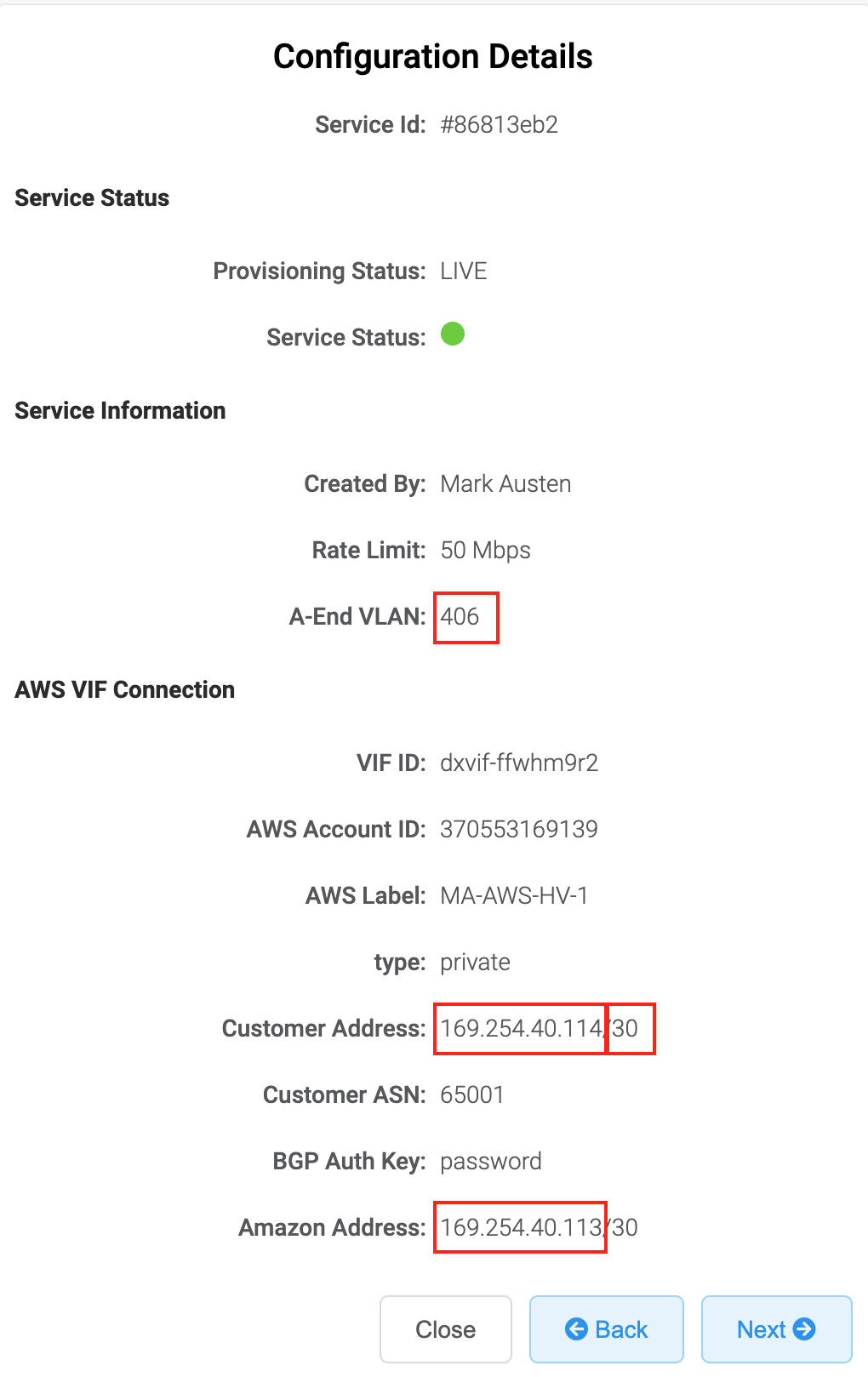
-
In Orchestrator, go to Configure > Edges and click the MVE device.
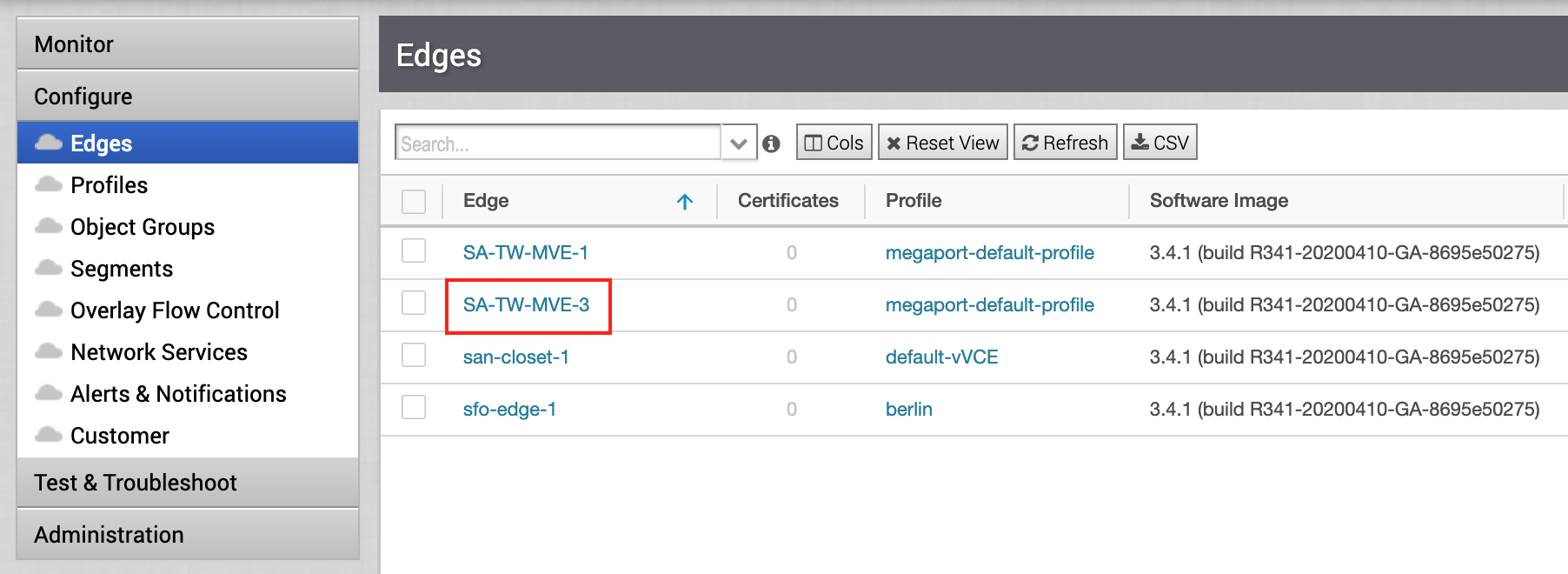
-
Select the Device tab and scroll down to the Interface Settings.
-
Click +Add Subinterface.
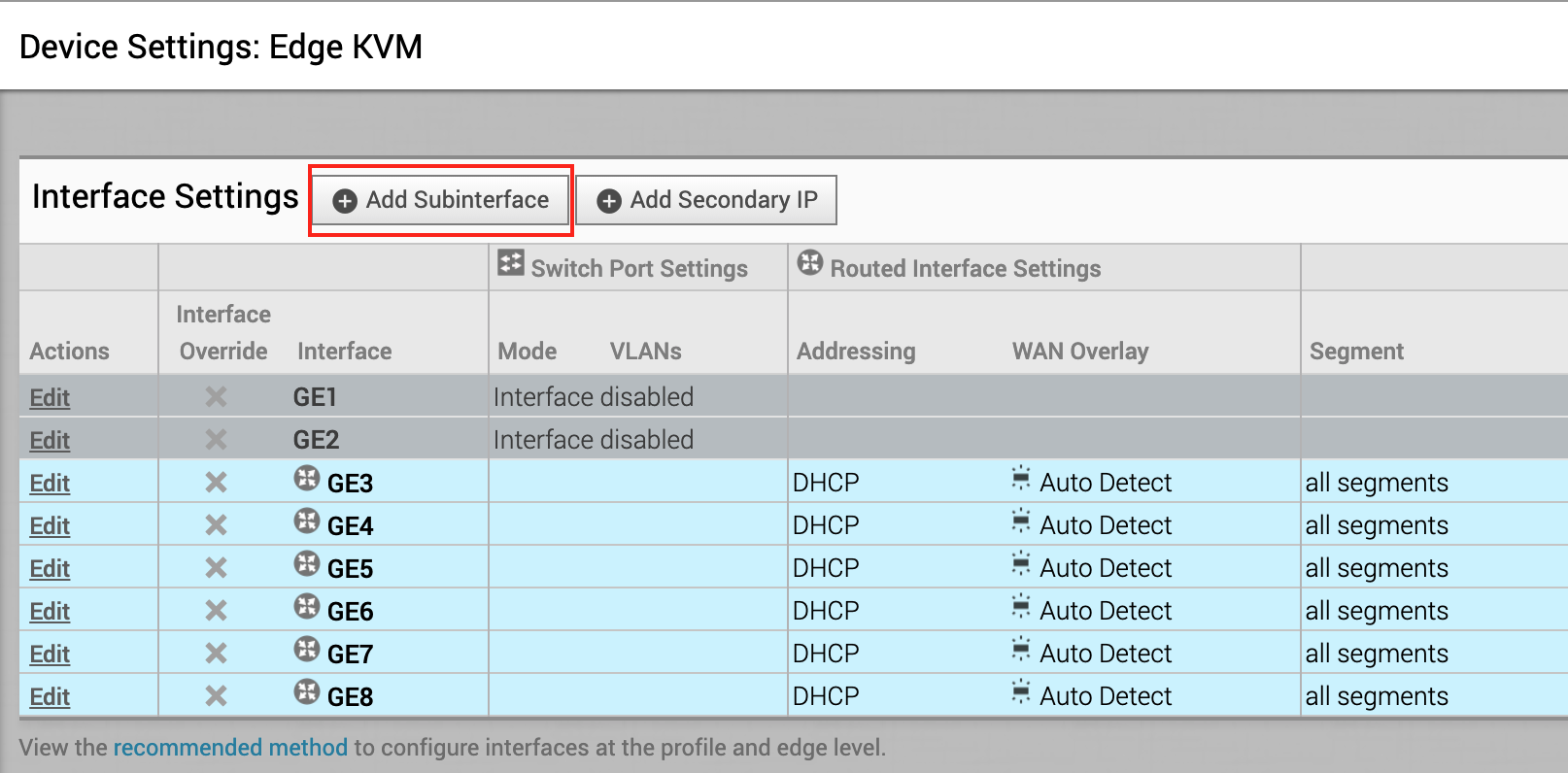
The Select Interface dialog box appears. -
From the Select Interface menu, choose GE3 and for the Subinterface ID enter the A-End VLAN ID configured on the MVE in the Megaport Portal.
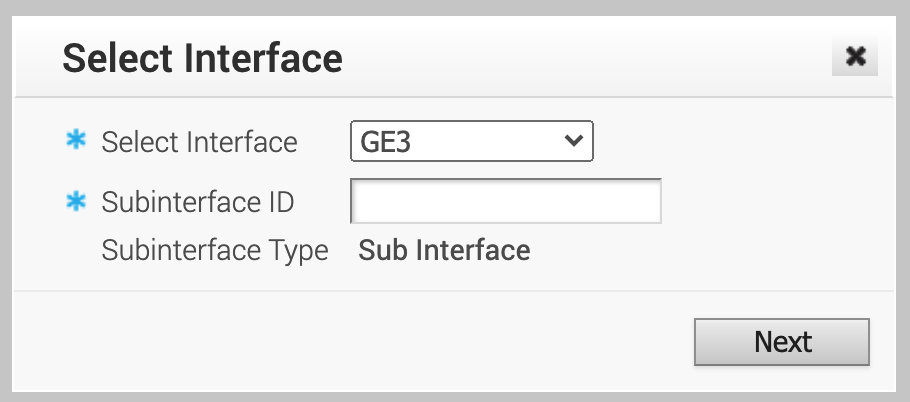
The subinterface settings appear. -
Change the Addressing Type to Static and provide the IP Address, CIDR value, and Gateway.
These values are available in the connection details on the Megaport Portal. The IP address and CIDR appear in the Customer Address field; the Gateway appears in the Amazon Address field.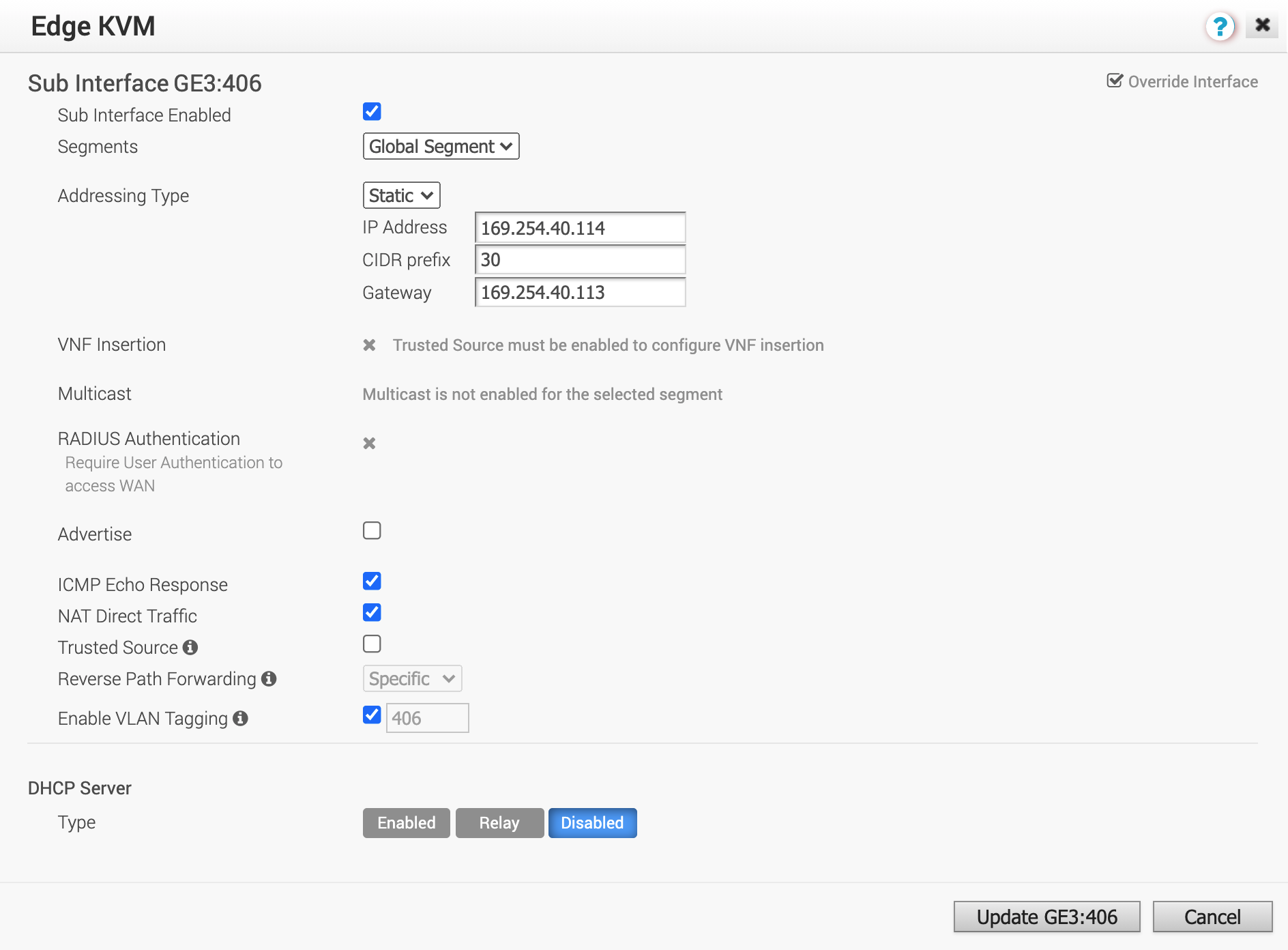
-
Ensure Enable VLAN Tagging is enabled.
The field is automatically populated with the VLAN ID you specified for the subinterface ID. -
Click Update GE3:vlan-id.
-
In the upper-right corner of the Configure > Edges window, click Save Changes and then confirm.
This configures the interface, VLAN tags, and IP addresses so you can test with ping commands through the CLI. (BGP is not yet configured.)Note
Adding the subinterface momentarily disrupts the connection.
To configure BGP for the AWS connection in Orchestrator
-
In Orchestrator, go to Configure > Edges and click the MVE device.
-
Select the Device tab and in the Configure Segments section click Enable Edge Override for BGP Settings.
This override lets us define BGP values specific for this device beyond the profile definition.
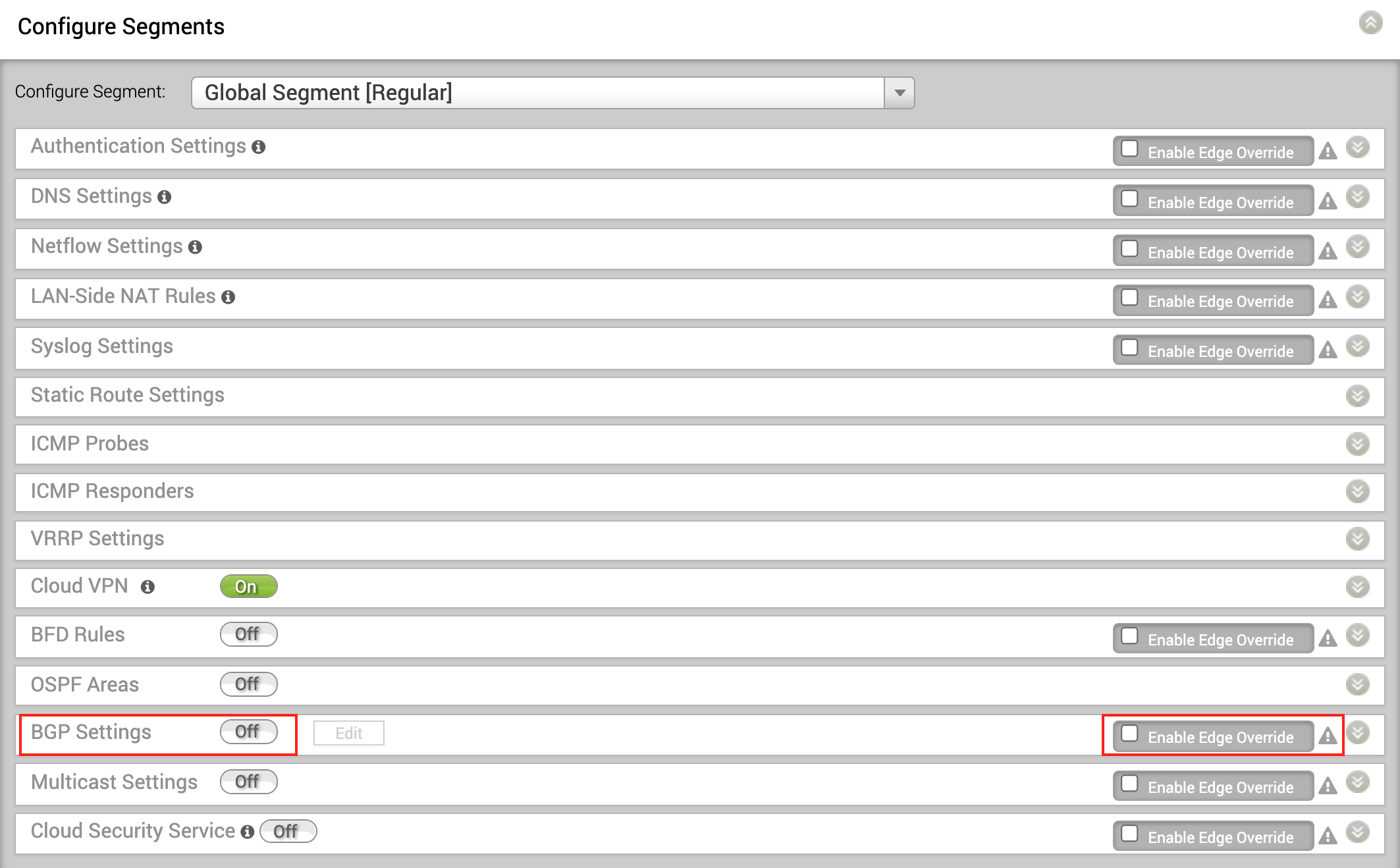
-
Click the toggle button to turn on BGP and click Edit.
The BGP Editor appears. -
For Local ASN, add the Customer ASN from the Megaport connection details.
-
For the Neighbor IP, add the Amazon Address from the Megaport connection details.
-
Add the Amazon ASN to the ASN field for the neighbor.
By default this is 64512. -
View all Additional Options and select MD5 Auth and enter your MD5 Password from the Megaport connection details.
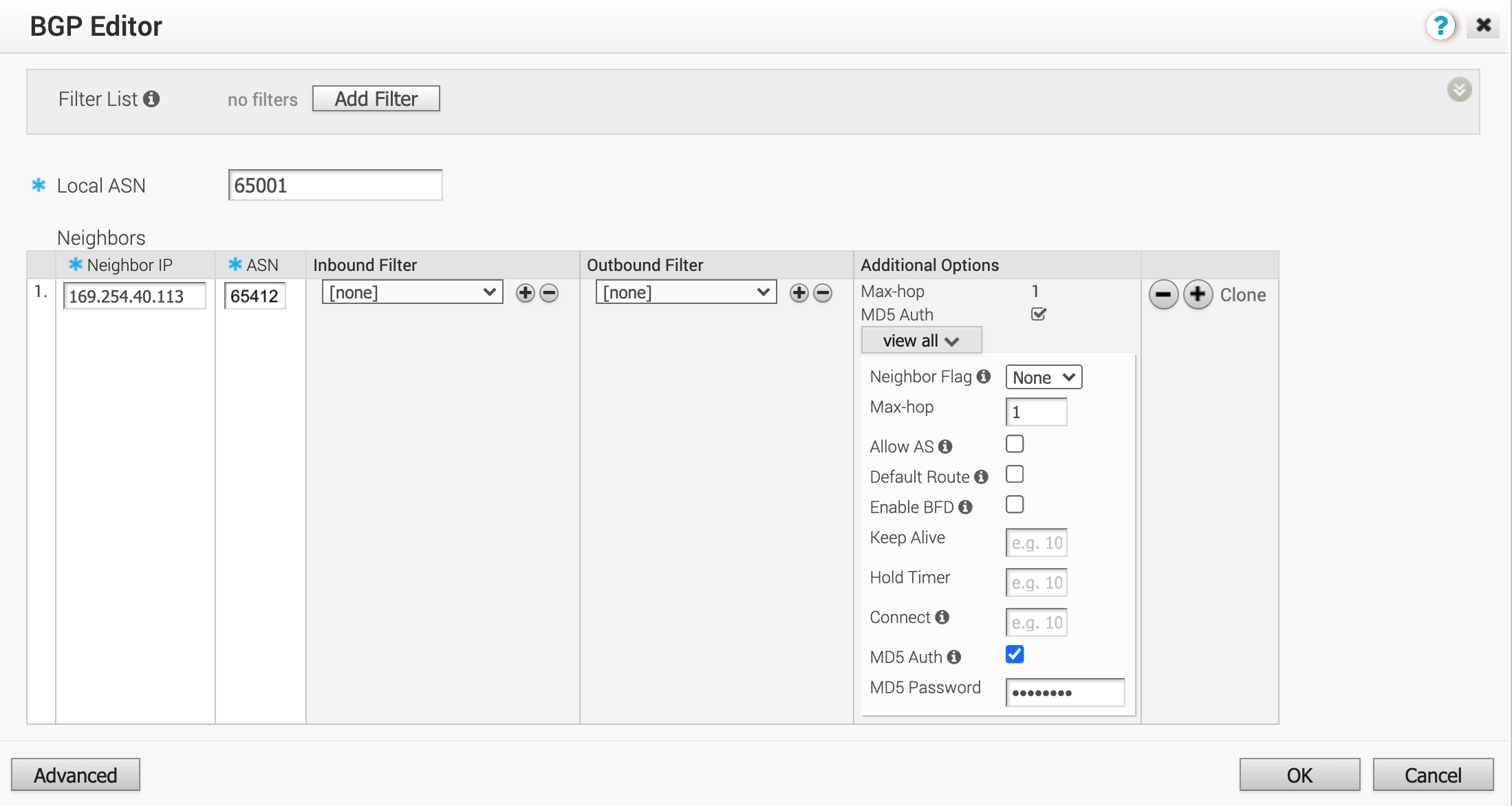
-
Click OK and then click Save Changes.
Validating your connection
The BGP connection can take approximately 5 minutes to establish. Once connected, you can verify the connection in both Orchestrator and AWS.
Under Test & Troubleshoot > Remote Diagnostics, select the MVE and click Run for Troubleshoot BGP - Show BGP Summary to verify the BGP session and ensure the AWS router is up.
You can also check connectivity and BGP status from the CLI of the edge device. For more information, see Reviewing your VMware MVE connection settings.
From the AWS console, confirm the state of the Virtual Interface (under the General Configuration tab) is available. The state changes to available when the BGP connection is established.